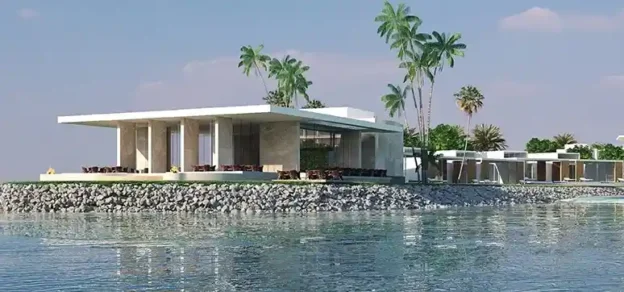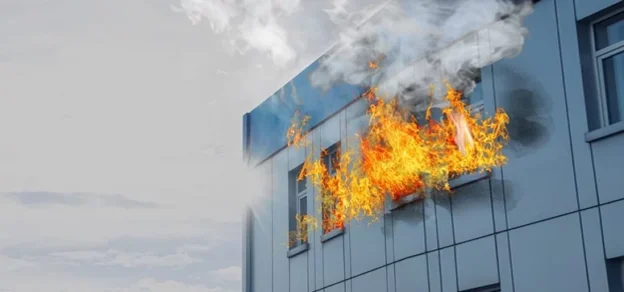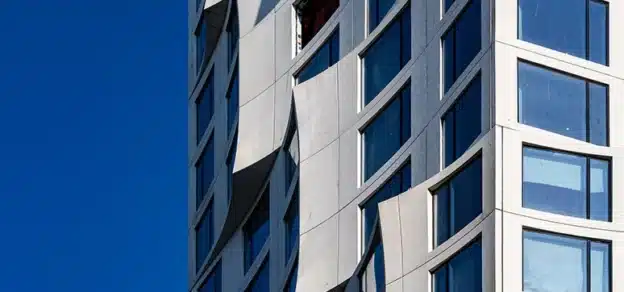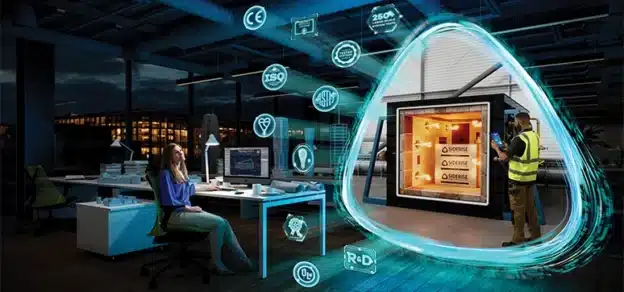The façade is a derivative of the French word, ’façade’ which means “frontage” or “face”. In architecture, the façade of a building is one of the most critical aspects from an aesthetic standpoint as it becomes the identity of the building, just like the face of a human being. Their façades recognize the most iconic buildings in the world. Fully glazed façades have become the industry standard when it comes to commercial office space design.
They enable natural lighting for larger floor plates compared with RCC and brick façades and impart an iconic perspective to the building. Developers can extract higher rentals for fully glazed buildings as compared to buildings with conventional façades. While consultants and designers focus remains on aesthetics, sustainability, new materials, and cost, the aspects of fire safety often get ignored. This article attempts to identify the fire risks associated with glass façades, their application concerning codes, and commercially available options to minimize the fire risks.
The spread of fire pertaining to glass façades:
- Poke through effect: Spread of fire from external fire to internal areas of a building.
- Chimney effect: Spread of fire and smoke through the gap between glazing and the slab.
- LeapFrog effect: Spread of fire from internal areas to upper floors through external façade.
Apart from the above, debris falling on a passer-by is also identified as a major risk during fire incidents. Before delving into the solutions for providing fire-rated façades, it is essential to be aware of the code requirements for the provision of fire-rated glass façades.
National Building Code 2016
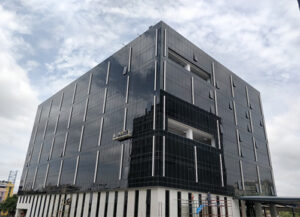
Previous versions of NBC were more suited for RCC buildings with brick and mortar façade with minimum openings. Masonry and RCC walls are by default 2-hour fire-rated. Hence, they comply automatically with fenestration fire rating criteria. This is not the case with glazing and other cladding materials, which are not fire-rated by default.
In India, awareness of the dangers of fire in buildings is prevalent. There are strict fire prevention and firefighting norms followed by every local fire force department regarding the design and implementation of suppression and detection system. With the widespread adaption of fully glazed façades, particularly in high-rise commercial buildings, there was a gap observed in codes in terms of the fire rating of the façade. Fire rating for glazed façades had remained fairly non-critical from the regulations perspective even though there are codes and tests as per NFPA and BS standards.
NBC 2016 has tried to bridge the gap by providing guidelines on the following aspects:
- Design and construction of glazing for buildings
- Building elements where fire-rated glass needs to be provided
- Details about fire-rated glazing assemblies, components, and requirements for testing
The code has listed out several norms for the fire safety of façades in high-rise buildings. Table 1 shows the tabulation of the relevant clauses and articles which dictate fire safety of glasses and building fenestration:
Inferences To National Building Code 2016
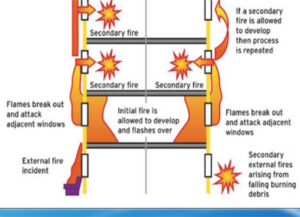
Based on the study of the clauses above and the codes, the following key points are brought out:
1. For buildings with a distance greater than 9m from adjacent buildings, normal tempered glass or above, is acceptable as a fenestration material, provided the same is installed in a non-flammable assembly. Care should be taken that the PVB coatings, sealants, etc. are also non-flammable.
2. Mandatory use of fire-resistant glass is restricted to usage in areas or elevations which require a specific fire rating.
These would include, but not be limited to:
a. Building elevations with a distance less than 9m from an adjacent building
b. Refuge balcony
c. Fire escape corridor
d. Staircase area if one or more elevations are with glazing
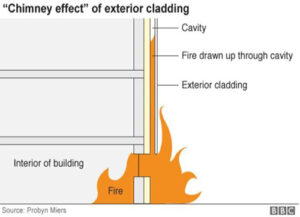
3. NBC acts as a guideline; however, the local fire authority is the final authority on fire norms to be followed. It is recommended that the consultants design the building to meet the more stringent requirements. (Local or NBC)
4. Providing openable panels is mandatory as per the codes. The code remains silent on the provision of fixed breakable panels instead of openable access panels.
5. Performance glasses with laminates are generally not fire-rated-rated. The PVB coating provided is not resistant to fire. Hence the use of the same should be restricted to the outer lite of glass. In fire-rated glass façades, the entire system should be performance tested and certified to be labeled as a fire-rated system. In the case of fire-rated DGU, where the outer lite is not fire-rated (performance glass for Green Building requirements), the entire system with all its constituents should be tested and certified as fire-rated.
6. The code further specifies each type of glass’s maximum width and size along with support conditions in elaborate tables.
Fire Spread – Mitigation Measures
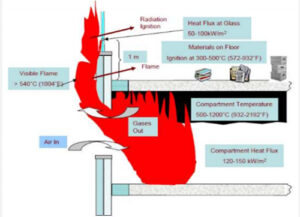
Below are the mitigation measures adopted to address the 3 types of fire spread on glazed façades:
Poke through effect:
This is applicable for buildings with a fire separation of less than 9 m. The only way to mitigate the fire spread through external fires is by using fire-rated glazing on the external façade. Some local authorities also insist on a row of sprinklers on the external parapet of the building to deluge the building façade with water and prevent the propagation of the external fire into the building. This also helps prevent inflammation of Façade components like glazing, sealants, coatings, etc. Also, internal compartmentation by tenants as per NBC recommendations is important to contain the fire spread within one compartment.
Chimney effect:
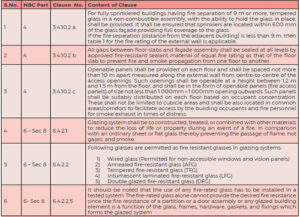
The codes have specified the use of fire-rated sealant at the gap between the curtain wall and slab to mitigate the chimney effect. Vertical or horizontal, all façades will have gaps at interface junctions and this is where the smoke and fire stop needs to be used. It acts as the barrier for fire or smoke to travel from one compartment to the other adjacent or vertical compartment. As laid out in NBC part 4, the gap between the glazing and the slab should be sealed with a material having an equal fire rating as the slab. Typical assembly is explained below: It is important to ensure the integrity of the system wherein the tenants extend their flooring to the façade mullion. To achieve this, additional stiffeners may have to be provided. Alternatively, RCC upstands may be provided above the system to ensure that the tenants do not extend their flooring till the glazing line.
LeapFrog effect:
Following points are proposed in the codes to mitigate the leapfrog spread of fire (Floor to floor fire spread from external face)
- Use of row of sprinklers 600 mm from glazing – This prevents the spread of fire in the area adjacent to the glazing and therefore prevents the spread to upper floors.
- Provision of openable fire – This allows smoke to escape away from the building and prevents build-up heat adjacent to the glazing.
Awareness About Fire Safety Norms And Standards
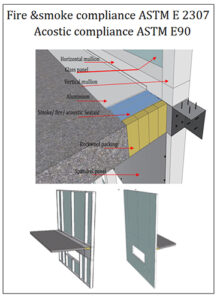
New norms specified in the latest edition of NBC are a start and should be followed in all projects irrespective of commercial or residential. The provisions should find mentioned in the Fire NOCs which are issued by local authorities. At present, there is a lot of ambiguity concerning the provision of codes and requirements of local authorities, where certain clauses of the code are ignored.
Different countries have different regulations and tests for façades and there are a large number of different tests used for verification and classification of façade systems, ranging from small-scale tests to full-scale tests and fire spread simulation using advanced models.
The following aspects should be considered by consultants while designing the Façade and material selection for Fire safety.
- Fire rating of the façade material and other cladding elements
- Provision of openable panels
- Façade treatment for refuge terraces
- Secondary protection measures for glazing like sprinklers, etc
- Fire sealing of the gap between glazing and structural slab edge
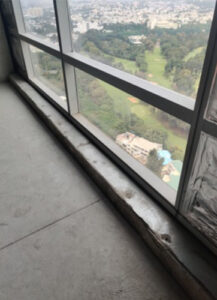
The following aspects have been quantified in various codes and standards for the selection of glass materials.
- Resilience to fire
- Rate of flame spread
- Time to ignition
- Chemical and convective heat release rates
- Mass loss rate
- Effective heat of combustion
- The heat of gasification and smoke yield
- Testing materials and façade systems as a whole is an important aspect of façade engineering. It is recommended that while selecting a material, compliance to Certification from a third party accreditation providers like Intertek, UL, etc. are made mandatory. It should be noted that as mandated by codes, the fire-rated glass façades should be tested as an assembly and not just for individual components like glass. Framing elements, sealants, coating, etc. should also be of the same fire rating as the glass selected.
- These certification bodies also conduct periodic inspections of the materials under production to witness the test and compliance to the standard and periodically issue certification for the application.
- It is important to ensure strict supervision during the installation of all fire-rated façades to ensure that the assemblies and consumables like sealants, flashing, etc are installed with the right material and in a correct manner.
- Apart from the above, it is important to note that the Fire-rated glass façades are approximately 300% expensive when compared to normal glazing façades. Utility and the application of the same in buildings are restricted to areas mandated by the codes or as per requirements of local authorities. Designers must identify such areas at the initial stage of the project to make budgetary provisions for the same and allow for a sufficient timeline in the schedule to procure and install including testing and certification of assembly.
Conclusion:

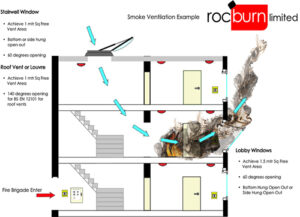
It is well established that glazed buildings are a much higher fire hazard when compared to brick and mortar façade buildings. This is majorly owing to the susceptibility of the complete disintegration of glazed façades in the event of major fires and the spread of fire through the external face of the building. This is established from several well-publicized fire accidents in high-rise buildings. The local authorities in India largely ignore the mandatory requirements of fire rating of glazed façades and applicability of the same to high-rise buildings. It should be ensured that the No Objection Certificates (NOC’s) issued in the future have clear and unambiguous requirements for glass fire rating.
The requirement of fire-rated façades must be evaluated objectively based on the building usage, fire separation, and risk assessment carried out for the entire building and glazing assembly, and not just as per prescriptive parameters.





